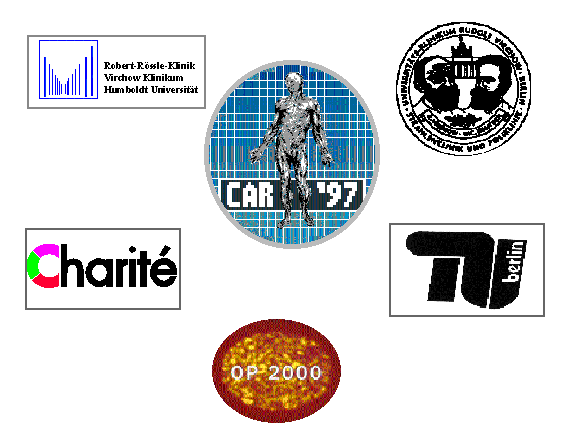

TELESURGERY The pervasive use of computer, video, laser and communication technologies has supplied the impetus for optimizing diagnostic and therapeutic procedures. The concept OP 2000 integrates these new technologies into an ambitious blueprint for an operating room of the future that meets the clinical demands of modern surgery:
The performance of the 34Mb/s and 17Mb/s satellite link was demonstrated at CAR'96 in Paris and by the first transatlantic 3-D teleconference between Chicago and Berlin (50th Annual Meeting of the American Society of Surgical Oncology, March 97). CAR'97 takes interactive telemedicine one step further by using a multipoint ATM link. http://www.rrk-berlin.de/op2000/ In cooperation with:
AVT, Carl Zeiss, |
DIGITAL RADIOLOGY Strahlenklinik und Poliklinik, Virchow-Klinikum Humboldt Universit�t Berlin For the past decade, digital image generation, communication and archiving as well as telemedicine and teleradiology have been major fields of research within the Dept. of Radiology at the Virchow-Klinikum Berlin. The overall objective has been to establish a department of digital radiology that should function as a fully integrated component within the advanced digital environment of the medical center itself, but also provide its services and medical expertise to a wider community of healthcare professionals outside the hospital. Picture- and report infrastructure for a digital radiology Several requirements were viewed as critical to achieving our objective: an open system architecture employing DICOM and HL7; the hospital-wide distribution of images in conjunction with reports; and of course the cost effectiveness of the system. All projects and efforts undertaken over the years have to be seen within this framework. Today we are a few steps closer to our goal: a hospital-wide ATM backbone has been established for high-speed image transmission; the majority of the imaging devices has been integrated into a PACS system using DICOM; a WWW-enabled system has been attached to the PACS allowing the retrieval of images and reports from every computer within the hospital network; in addition, this system grants access to associated hospitals and medical practitioners. Although the results attained thus far are acceptable, everyone is aware that there is still a long way to go. Digitale Radiologie: Dr. B. Bergh, D. Emmel, Dr. J. Ricke, I. Schramm, J. Thomsen, C. Zielinski, Contact: [email protected] Strahlenklinik and Poliklinik Virchow-Klinikum Berlin |
| MediCAL Dept. of Computer Science, Computer Graphics Group, TU Berlin
http://www.cg.cs.tu-berlin.de/ MediCAL is supported by Hewlett Packard and Informix
|
AMBA Computer Vision in
Pathology Institute of Pathology, Rudolf-Virchow-House, Charit�, HU Berlin The Pathology Workplace 2000 combines on- and offline telepathology via ISDN, LAN and WAN with pathology information systems and image databases. A pathologist’s diagnosis may in the near future be assisted by the fast conveyance of second opinions via telepathology and by access to diagnostic image databases in combination with computer-aided interpretation. AMBA group: Dr. P. Hufnagl, Dr. G. Wolf, Dr. I. Petersen, Dr. C. Tennstedt, In cooperation with: Dipl.-Ing. T.-N. Nguyen-Dobisky (Dept. of Prenatal Diagnostics), Dr. K. Roth (Dept. of Anatomy) The optimal integration of telepathology within the pathologist’s workflow is the key to the technology’s acceptance in the daily routine. The development of programs for the automated comparison, analysis and interpretation of histological images will usher in a new era in pathology. A comparable change is expected for education using multimedia databases and virtual histological cases. http://www.charite.de/ch/patho/ Partners: Leica Wetzlar, Carl Zeiss Jena, IBSB Berlin, Olympus Hamburg, Viewpoint Gilching |

